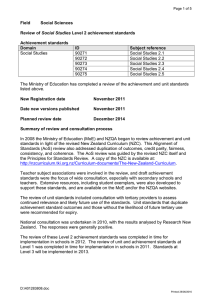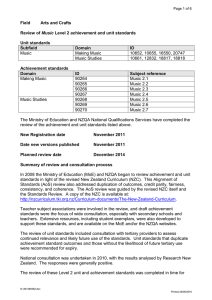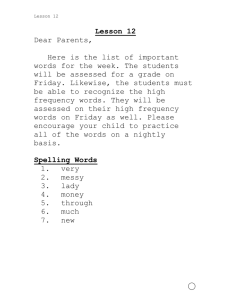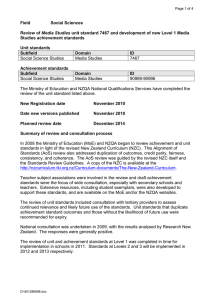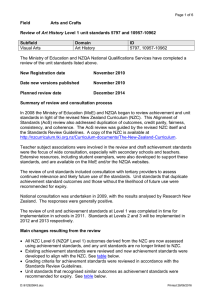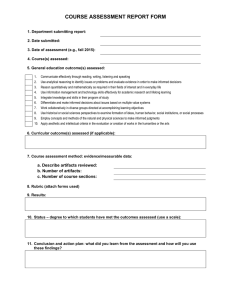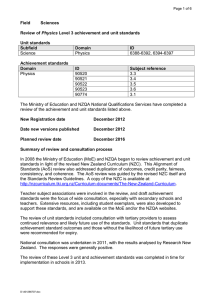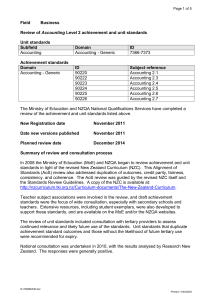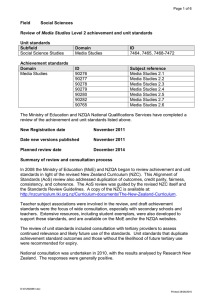revsumnov11 29
advertisement
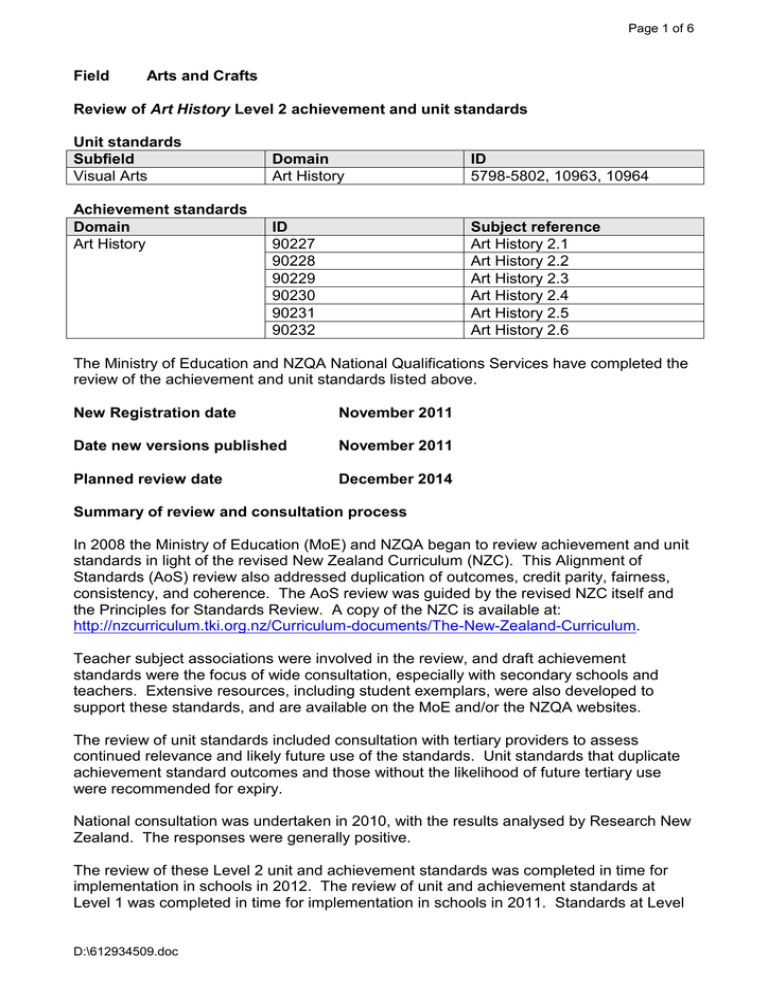
Page 1 of 6 Field Arts and Crafts Review of Art History Level 2 achievement and unit standards Unit standards Subfield Visual Arts Achievement standards Domain Art History Domain Art History ID 5798-5802, 10963, 10964 ID 90227 90228 90229 90230 90231 90232 Subject reference Art History 2.1 Art History 2.2 Art History 2.3 Art History 2.4 Art History 2.5 Art History 2.6 The Ministry of Education and NZQA National Qualifications Services have completed the review of the achievement and unit standards listed above. New Registration date November 2011 Date new versions published November 2011 Planned review date December 2014 Summary of review and consultation process In 2008 the Ministry of Education (MoE) and NZQA began to review achievement and unit standards in light of the revised New Zealand Curriculum (NZC). This Alignment of Standards (AoS) review also addressed duplication of outcomes, credit parity, fairness, consistency, and coherence. The AoS review was guided by the revised NZC itself and the Principles for Standards Review. A copy of the NZC is available at: http://nzcurriculum.tki.org.nz/Curriculum-documents/The-New-Zealand-Curriculum. Teacher subject associations were involved in the review, and draft achievement standards were the focus of wide consultation, especially with secondary schools and teachers. Extensive resources, including student exemplars, were also developed to support these standards, and are available on the MoE and/or the NZQA websites. The review of unit standards included consultation with tertiary providers to assess continued relevance and likely future use of the standards. Unit standards that duplicate achievement standard outcomes and those without the likelihood of future tertiary use were recommended for expiry. National consultation was undertaken in 2010, with the results analysed by Research New Zealand. The responses were generally positive. The review of these Level 2 unit and achievement standards was completed in time for implementation in schools in 2012. The review of unit and achievement standards at Level 1 was completed in time for implementation in schools in 2011. Standards at Level D:\612934509.doc Page 2 of 6 3 will be implemented in 2013. Main changes resulting from the review All NZC Level 7 (NZQF Level 2) outcomes derived from the NZC are now assessed using achievement standards, and there are no longer any unit standards linked to the NZC. Existing achievement standards were reviewed and new achievement standards were developed to align with the NZC. See table below. Grading criteria for achievement standards were reviewed in accordance with the Standards Review Guidelines. Unit standards that recognised similar outcomes as achievement standards were replaced or recommended for expiry. See table below. For a more detailed description of the review of, and the changes to, the Art History standards see the appendix at the end of this report. Impact on Consent and Moderation Requirements (CMR) (Formerly known as AMAP) All new achievement standards were registered on CMR 0233. Impact of changes on NCEA Exclusions List For transition purposes, the following exclusions will apply for new achievement standards. Achievement standard 91180 (2.1) 91181 (2.2) 91182 (2.3) 91183 (2.4) 91184 (2.5) 91185 (2.6) 91186 (2.7) Excluded against each of these standards 90227 90228 5800, 90230 90229 5802, 90231 5799 5801, 90232 Review Categories and changes to classification, title, level, and credits The following summary shows the changes made to the standards as a result of the review. All changes are in bold. Where a new or a new version of an externally assessed achievement standard is registered, the following designation appears after the title [Externally Assessed]. Key to review category A B C D Dates changed, but no other changes are made - the new version of the standard carries the same ID and a new version number Changes made, but the overall outcome remains the same - the new version of the standard carries the same ID and a new version number Major changes that necessitate the registration of a replacement achievement standard with a new ID Achievement standard will expire and not be replaced D:\612934509.doc Page 3 of 6 Externally assessed achievement standards categorised as category C expire at the end of December 2011 Internally assessed achievement standards and unit standards categorised as category C or D expire at the end of December 2012 Arts and Crafts > Visual Arts > Art History ID Title Level 5798 5799 91185 Examine and compare art works Communicate responses to art Communicate a considered personal response to art works Investigate art within cultural and/or social contexts Examine an art movement Examine the influence of context(s) on art works [Externally Assessed] Examine art in the environment Examine art works in their environmental contexts Demonstrate understanding of art works in relation to their physical environments 2 2 2 Credit Review Category 6 D 4 C 4 2 6 C 2 2 4 4 C 2 2 2 4 4 4 C C Gather and process information and apply it to a selected art history topic Research an art history topic Communicate understanding of an art history topic Investigate an art movement Examine iconography in art Discuss art works Examine the effects of formal elements of art works [Externally Assessed] Examine subjects and themes in art Examine the meanings conveyed by art works [Externally Assessed] Examine techniques used in art Examine how media are used to create effects in art works 2 4 C 2 2 4 4 C 2 2 2 2 6 4 4 4 D D C 2 2 4 4 C 2 2 4 4 C 5800 90230 91182 5801 90232 91186 5802 90231 91184 10963 10964 90227 91180 90228 91181 90229 91183 D:\612934509.doc Page 4 of 6 Appendix Development of L2 Standards Process of Aligning Standards with the New Zealand Curriculum The process began with analysing the curriculum document to determine where Art History sat within the curriculum ie Visual Arts. A draft essence statement was developed to determine the essential concepts and skills of the subject. The key competencies were then linked to Art History teaching practice. Existing achievement standards and unit standards were audited against the achievement objectives in the Visuals Arts curriculum and against the key competencies. New achievement standards were then developed based on this audit and in response to feedback from interest groups. The content of the achievement standards was therefore updated to ensure alignment with the Visual Arts strands: ‘Communicating and Interpreting’ and ‘Understanding the Arts in Context’. Many of the Level 7 achievement objectives such as ‘Use critical analysis to interpret and respond to art works’, and ‘Research and analyse how art works are constructed and presented to communicate meanings’ are relevant to the study of Art History and align closely with art historical skills. Some of the skills assessed in unit standards 5798, 5800, 5801, 5802, 10963, and 10964 were incorporated into the newly developed Level 2 achievement standards. Where the new achievement standards recognise similar skills to those recognised by the unit and achievement standards, this is reflected in the replacement relationships. Addressing Credit Parity The credit weightings for the Level 2 achievement standards remain unchanged with each standard worth 4 credits. This recognises the equal importance of each of the assessed outcomes and also reflects the equivalence of work anticipated for each standard. External and Internal Assessment Seven Level 2 Art History standards were developed: three are externally assessed and four are internally assessed. It is not expected that students will be assessed against all of these standards. The removal of the 24 credit limit at each level of the Art History matrix provides a wider range of internal standards for teachers and students to select from; and also enables teachers to decide on a suitable balance of external and internal assessment. What has changed? All of the newly developed Level 2 Art History achievement standards now include a single achievement criterion so that a single learning outcome is assessed. For example, AS91183 (2.4) Examine how media are used to create effects in art works requires students to ‘Examine how media are used to create effects…’ for the Achieved grade and to ‘Examine perceptively how media are used to create effects...’ for the Excellence grade. This change clarifies the criteria for assessment. Where comparisons are made in the following paragraphs, these comparisons are between the reviewed standards and the newly developed standards. D:\612934509.doc Page 5 of 6 2.1 Examine the effects of formal elements of art works (AS91180) The phrase ‘formal elements’ in this standard replaces ‘key characteristics’ in the replaced AS90227 for consistency with the terminology used in the newly developed Level 1 standards. This standard focuses on students demonstrating their ability to examine properties of art works such as colour and composition. 2.2 Examine the meanings conveyed by art works (AS91181) The broader term ‘meanings’ in this standard replaces the phrase ‘subject matter and themes’ in the replaced AS90228. This enables a broader discussion of the meanings conveyed by art works. 2.3 Examine the influence of context(s) on art works (AS91182) AS90230 Examine an art movement (2.4) and unit standard 5800, Investigate art within cultural and/or social contexts, were replaced by this standard which focuses on the influence of contexts on art works rather than focusing on context and art movements. 2.4 Examine how media are used to create effects in art works (AS91183) The term ‘media’ in this standard replaces the term ‘techniques’ in the replaced AS90229. In this standard, the term ‘media’ is more broadly defined as ‘the materials and/or medium and/or technical means used to create art works’. This definition enables a wider range of approaches to be explored, eg the effects of paint application through to the effects created by digital media. 2.5 Communicate understanding of an art history topic (AS91184) The intent of this standard is similar to that of the replaced AS90231 Research an art history topic (2.5), but the steps in undertaking research (including the term ‘Develop a research plan...’) are no longer included in the achievement criteria. The replacement standard instead focuses on students communicating understanding of the art history topic. Some elements of a research approach are nevertheless required and are stated in the explanatory notes, eg ‘selecting and processing relevant information’. These changes enable more holistic assessment of students’ work. This standard also replaced unit standard 5802, Gather and process information and apply it to a selected art history topic. 2.6 Communicate a considered personal response to art works (AS91185) This standard is a newly developed standard; it replaces unit standard 5799, Communicate responses to art, but it does not replace any of the reviewed standards. The standard focuses on student responses to art works. Assessment against this standard could involve discussion of art works seen at exhibitions or, for example, art works accessible in local communities. 2.7 Demonstrate understanding of art works in relation to their physical environments (AS91186) This standard replaces AS90232 and unit standard 5801. The term ‘physical D:\612934509.doc Page 6 of 6 environment’ distinguishes the focus of this standard from the ‘contexts’ focus of AS91182 Examine the influence of context(s) on art works (2.3). D:\612934509.doc
